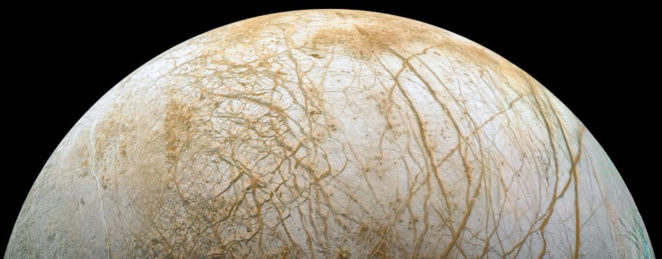
Europa is the smallest of the four Galilean moons of Jupiter
– so called because they were discovered by Galileo in 1610. With a diameter of
3138 km (1950 miles) it is the only one of the four that is smaller than
Earth’s Moon. Europa orbits Jupiter at a distance of 671,000 km (417,000 miles)
and a complete orbit takes 3.55 Earth days. This orbital distance is nearly
twice as great as that of our own Moon, but Europa is moving very much more
quickly – not only does our Moon take 27.32 days to orbit Earth, the planets
being orbited are vastly different in size, Jupiter being 11 times larger than
Earth.
From a distance Europa appears to be a smooth, white ball of
ice, but a closer view reveals pale markings that criss-cross its surface, and
very few impact craters. This suggests that there is a constant renewal process
at work.
Europa is subject to tidal pressures caused by the
gravitational pulls of Jupiter and the neighbouring moons of Io and Ganymede.
This leads to flexing that produces heat, which in turn leads to the presence
of liquid water that is trapped between a rocky core and a crust of ice.
Where the crust fractures, jets of water escape in high arcs
that freeze when they hit the surface.
It is quite possible that undersea volcanoes pump chemicals into
the oceans and this could lead to the creation of the building blocks of life,
which is how many scientists think life began on Earth.
There is therefore the intriguing possibility that Europa
harbours living organisms of some kind. Should this be so, the fact that two
bodies in our Solar System are life-bearing must make it almost certain that
there is life on planets that orbit other stars that are relatively close to
our Sun.
In Greek mythology Europa was a high-born woman who was
abducted by Zeus in the form of a white bull. She then gave birth to King Minos
of Crete. The continent of Europe takes its name from her.
No comments:
Post a Comment